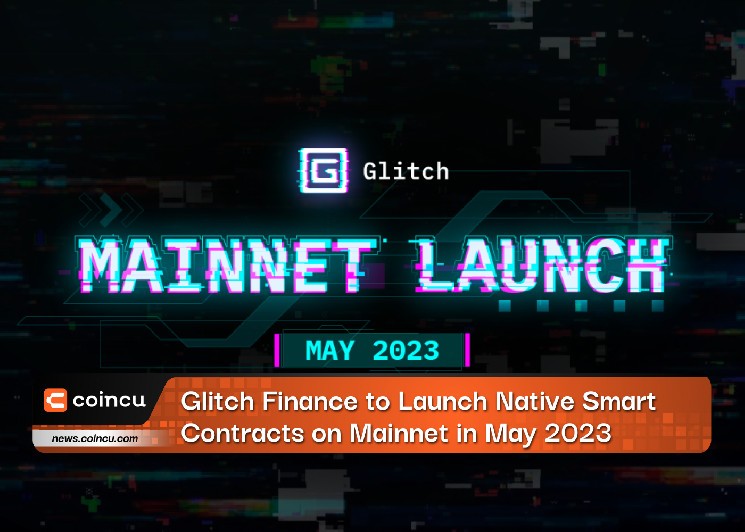Glitch Finance to Launch Native Smart Contracts on Mainnet in May 2023

Smart Contracts: Advantages, Challenges, and the Need for Scalability and Interoperability
Smart contracts, the backbone of DeFi, are self-executing digital agreements that operate on a blockchain, cutting out the middleman and eliminating the need for centralized control. These innovative tools open the door for users to engage in a myriad of DeFi services, from lending and borrowing to trading and staking. However, as the saying goes, there’s no such thing as a free lunch. Many current smart contract platforms are bogged down by network congestion, sky-high gas fees, and limited compatibility with other blockchains.
Native smart contracts are seen as the missing link in the evolution of the crypto ecosystem. They empower users and developers to create and participate in a wide array of decentralized applications (dApps), which offer not only peer-to-peer functionality but also security, reliability, and accessibility. In essence, native smart contracts grease the wheels of complex transactions and processes, making them run smoothly without intermediaries or centralized authorities.
That being said, native smart contracts aren’t a walk in the park either. They face their own set of challenges, which can hinder their potential and adoption. Scalability, the capacity for a blockchain network to manage a large volume of transactions and users without sacrificing performance or security, remains a stumbling block for many existing platforms. Issues like network congestion, exorbitant gas fees, and low throughput throw a wrench in the user experience and profitability of dApps.
Another challenge is interoperability, which refers to the ability of different blockchain networks and protocols to communicate and exchange data and value with each other. Currently, most smart contract platforms operate in silos, which create barriers and inefficiencies for cross-chain collaboration and innovation. Interoperability is crucial for creating a more connected and diverse crypto ecosystem that can offer more choices and opportunities for users and developers.
Optimizing DeFi with Custom-Built Blockchain and Substrate Framework
Glitch aims to solve these challenges by providing a custom-built blockchain that is optimized for DeFi use cases. Glitch leverages the Substrate framework, which allows it to be fast, interoperable, and blockchain-agnostic. Glitch also utilizes a decay Nominated Proof of Stake system to ensure network security and decentralization.
According to the announcement, Glitch will launch native smart contracts on its mainnet in May 2023, following a successful testnet phase that started in January 2022. The native smart contracts will be compatible with the Ethereum Virtual Machine (EVM), which means that developers can easily port existing Ethereum dApps to Glitch with minimal changes. Additionally, Glitch will support token wrapping bridges that will allow users to swap any token from any native chain for any token within the Glitch ecosystem.
The launch of native smart contracts on Glitch is expected to attract more developers and users to the platform, as well as foster innovation and growth in the DeFi space. Glitch claims that its ultimate goal is to become a cornerstone of blockchain infrastructure and provide better access, lower costs, and novel community reward mechanisms for DeFi dApps.
Glitch Finance is a layer-one protocol built on the Substrate Framework designed to be fast, interoperable, and blockchain-agnostic, with a singular focus on trustless money markets and decentralized financial applications (DeFi dApps). GLCH is the native utility token of the Glitch network that is used for governance, staking, fee payment, and reward distribution.
Conclusion
The launch of native smart contracts on mainnet in May 2023 promises to be a game-changer for the DeFi landscape. By addressing the key challenges faced by existing smart contract platforms, such as scalability and interoperability, this development aims to foster innovation and growth within the crypto ecosystem. With the integration of the Substrate framework and Ethereum Virtual Machine compatibility, it is poised to provide a seamless and efficient platform for decentralized applications. By breaking down barriers and improving user experience, this new wave of technology aspires to become a cornerstone of blockchain infrastructure, ultimately benefiting DeFi dApps, developers, and users alike.
DISCLAIMER: The Information on this website is provided as general market commentary and does not constitute investment advice. We encourage you to do your own research before investing.






 Bitcoin
Bitcoin  Ethereum
Ethereum  Tether
Tether  USDC
USDC  TRON
TRON  Dogecoin
Dogecoin  Cardano
Cardano  Bitcoin Cash
Bitcoin Cash  Chainlink
Chainlink  LEO Token
LEO Token  Stellar
Stellar  Zcash
Zcash  Monero
Monero  Litecoin
Litecoin  Hedera
Hedera  Dai
Dai  Cronos
Cronos  OKB
OKB  Tether Gold
Tether Gold  Ethereum Classic
Ethereum Classic  KuCoin
KuCoin  Gate
Gate  Algorand
Algorand  Cosmos Hub
Cosmos Hub  VeChain
VeChain  Dash
Dash  Tezos
Tezos  Stacks
Stacks  TrueUSD
TrueUSD  IOTA
IOTA  Basic Attention
Basic Attention  Decred
Decred  Theta Network
Theta Network  NEO
NEO  Synthetix
Synthetix  Qtum
Qtum  Ravencoin
Ravencoin  0x Protocol
0x Protocol  DigiByte
DigiByte  Zilliqa
Zilliqa  Nano
Nano  Numeraire
Numeraire  Siacoin
Siacoin  Waves
Waves  Ontology
Ontology  Enjin Coin
Enjin Coin  Status
Status  BUSD
BUSD  Pax Dollar
Pax Dollar  Hive
Hive  Lisk
Lisk  Steem
Steem  Huobi
Huobi  NEM
NEM  OMG Network
OMG Network  Augur
Augur  Bitcoin Gold
Bitcoin Gold  Ren
Ren  Bitcoin Diamond
Bitcoin Diamond